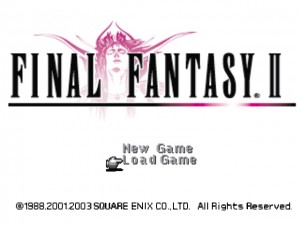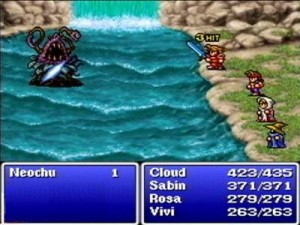 This week, I reached the first major milestone in my year-long journey: I completed the first game in the series, the original Final Fantasy. Immediately afterwards, I began Final Fantasy II, and before I go any further into describing that, I’d like to make a clarification for those who maybe aren’t as versed in (read as “obsessed with”) the series as I am.
This week, I reached the first major milestone in my year-long journey: I completed the first game in the series, the original Final Fantasy. Immediately afterwards, I began Final Fantasy II, and before I go any further into describing that, I’d like to make a clarification for those who maybe aren’t as versed in (read as “obsessed with”) the series as I am.
Many people have played a game called Final Fantasy II. These were not, however, all the same game. In 1988, one version was released solely in Japan for the Famicom. This Final Fantasy II was the actual second game in the series, and is the one I’ve been playing this week (and therefore the one I’ll be referring to throughout these entries). It wasn’t released in North America or Europe until 2003, as part of the Origins collection for PlayStation; this is the version I’m currently playing.
The other, however, is the one which was probably played by more people, and the one which many people probably still think of when the name Final Fantasy II is brought up. This was released in 1991 for the SNES, and was actually the fourth game in the series, so in Japan (as well as in subsequent re-releases on the PlayStation, GBA, DS, and so forth), it was Final Fantasy IV, and everywhere else, it was Final Fantasy II (“to avoid confusion,” otherwise known as “Square thinks Westerners are dumb”).
That’s perfectly clear, right? Of course it is.
Final Fantasy II is a very different game from just about any other in the series, but it’s perhaps most notable for being markedly different from its immediate predecessor. JRPGs, certainly those which originated in that particular era, didn’t really make a habit of changing formulas that worked, because…well, because they WORKED. With Final Fantasy being a raging success, it’s hard to imagine a company that would take that formula and basically toss it out the window for the follow-up, and yet that’s exactly what Square did. While I commend their desire to shake things up and not simply rest on their laurels, I definitely think it’s easy to see why this particular game didn’t make it out of Japan to begin with.
The first notable difference between Final Fantasy and Final Fantasy II comes in the form of the party you are given to progress through your quest. Rather than being simple empty vessels with no direction or character, you are given three named, distinctive party members (Firion, Maria, and Guy, with a fourth member frequently rotating in and out as the story dictates), and rather than simply being dropped in front of a castle with no idea what you’re doing there, you are introduced to these characters by gaining control of them in a futile battle against hostile forces, during which you are summarily cut down, regaining consciousness in a rebel base.
So far, this probably sounds pretty promising, and it is, briefly. New concepts are added from the start, including a “Word Memory” system wherein you have the option to memorize key words (helpfully highlighted in red text) when speaking with other characters that are then useful to open up dialogue options and story paths later on in the game. If nothing else, it’s definitely a more in-depth setup than the first game had.
 The problems I have with Final Fantasy II, however, start when you actually have to get into combat. Any character can use any weapon from the start, so you still have the ability to customize your party to your liking, which is great. In lieu of experience points, however, your party simply gets better at doing things by actually doing them. Sword skill gets better as you use a sword; defense gets better as you get hit, and so on. In more recent years, games like the Elder Scrolls series have, of course, used this particular mechanic to great effect, but it plays a lot differently when you’re trying to manage a party of three or four characters as opposed to primarily worrying about one.
The problems I have with Final Fantasy II, however, start when you actually have to get into combat. Any character can use any weapon from the start, so you still have the ability to customize your party to your liking, which is great. In lieu of experience points, however, your party simply gets better at doing things by actually doing them. Sword skill gets better as you use a sword; defense gets better as you get hit, and so on. In more recent years, games like the Elder Scrolls series have, of course, used this particular mechanic to great effect, but it plays a lot differently when you’re trying to manage a party of three or four characters as opposed to primarily worrying about one.
For example, the character I’m training to use black magic uses a bow as her primary weapon. This means that she can stay in the back row of fighters, which in turn means that she cannot be directly hit by the enemy. This SOUNDS like a great idea, right? It’s pretty fantastic—until you realize that when you begin to encounter enemies that have attacks which will reach your back line (bows and so forth), your now tragically under-leveled mage collapses at the slightest breeze because her hit points have not been built up enough to withstand an attack.
So, what’s the solution to this dilemma? Simple: you have to attack your own party members. In each battle, I have one party member whose role is not to attack the actual enemy threatening us, but rather to beat on his own companions with a stick until they get tougher. Does this seem backward to anyone else?
WEEK 3 PROGRESS: Final Fantasy completed (final time: 15 hours 41 minutes); 4 hours 6 minutes into Final Fantasy II